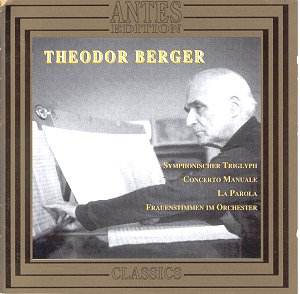Theodor BERGER (1905-1992)
Orchestral Works
Symphonischer Triglyph (1957)
Concerto Manuale (1951)
La Parola (1954)
Frauenstimmen (1959)
Triglyph - NDR SO/Horst Stein
Manuale - Bavarian RSO/Rafael Kubelik
Parola - Bavarian RSO/Rudolf Alberth
Frauenstimmen - Bavarian RSO/Rafael Kubelik
ADD from stereo radio tapes: Triglyph from NDR; the other three from
Bavarian Radio
 ANTES EDITION BM-CD
31.9047 [64.02]
ANTES EDITION BM-CD
31.9047 [64.02]

Berger was a pupil of Franz Schmidt but his natural way of speaking has only
a little to do with Schmidt's sustained singing lines. His time in Berlin
from 1932 to 1939 put him in touch with Furtwängler who took him under
his wing and promoted performances of Berger's music in Germany and abroad.
From 1939 onwards his home was to be Vienna with long interludes in the USA.
The Triglyph is a metamorphosis on unidentified themes from Schubert's
chamber music. It is a work of ferocious contrasts. The rushing galloping
strings with brass and percussion barrages (Schuman and Mennin) is set alongside
radiant lyrical andante chapters (Mahlerian adagio meeting
Schubert and Bruckner). Horst Stein has the measure of the oddly unassimilated
contrasts.
The Concerto Manuale patters conspiratorially with much florid
activity from two pianos, marimba and vibraphone. Its Hungarian outlook borrows
from Bartók - especially from the Concerto for Orchestra. The
percussive orientation is thrown into relief by the exclusion of woodwind
from the orchestra. The soloists: Ludwig Schessl, Karl Steinburger, Gernot
Kahl, and Wolfgang Schubert.
La Parola, effectively a serious overture for virtuoso orchestra,
has the bloodrush razor-edged bubbling vitality of the animated sections
of the Triglyph. Surely Berger must have encountered William Schuman's
orchestral scores during his stays in the US.
The Frauenstimmen (women's voices) again elides the wind parts
but this time replaces them with a vocalising women's choir. This is a work
of great delicacy - a facet of Berger's character. It is in three movements
and drifts in watery depths much emphasised by perfumed roles for two harps
and strings. The work is a shivering impressionistic approximation of Ravel
(Daphnis) and Vaughan Williams (Antartica). The Gesichte
im Fieberschlaf middle movement flickers with incessant action and the
inventive choral writing recalls William Mathias's This Worldes Joie.
Although in three sections Antes sets this 24 minute work in a single
track. Its linkage back to the delicate tracery of the 1948 Homerische
Symphonie is clear enough.
Berger has other dimensions apart from those fully on display here. The 1941
Legende vom Prinz Eugen has an heroic aspect - politically suspicious
given the date, and the multiform lyrical web of the Homerische Symphonie
(1948) is well worth encountering if you can trace an off-air recording.
The Symphony was broadcast by Kubelik with the Bavarian RSO while
Eugen was conducted by Oswald Kabasta with the Munich PO. The
Sinfonia Parabolica (1956) was broadcast by the Berlin PO with Karajan.
The 1964 violin concerto was relayed from Munich with Christoph von Dohnanyi
conducting and Odnoposoff the soloist. By the way all four tracks are taken
from broadcasts (presumably 1970s and 1980s) and suffer with some vestigial
hiss and with a little low level audience noise.
Well worth exploring.
Rob Barnett
CONTACT DETAILS
Bella Musica Edition
distribution@bellamusica.de
Bella Musica Edition (Antes Edition)
Eisenbahnstr. 30
D-77815 BÜHL
Telephone: +49 (0)7223-98550
Telefax: +49 (0)7223-985566

